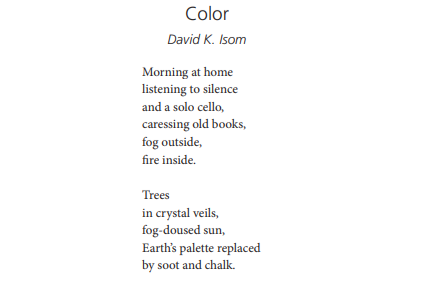Articles/Essays – Volume 54, No. 4
Color
Podcast version of this piece.
Morning at home
listening to silence
and a solo cello,
caressing old books,
fog outside,
fire inside.
Trees
in crystal veils,
fog-doused sun,
Earth’s palette replaced
by soot and chalk.
No color.
Only grays,
darker or lighter.
No real black.
No clean white.
Beth Cranston died
this morning, the only old-
timer still in my old
neighborhood,
except for Rod’s mom
and my mom
and Mr. Humbert.
Beth, exhausted
from succoring her
blind brothers,
blind son, grandson,
great-grandson.
Blindness carried only by
women, worn only by
men. Each generation
deciding to have a baby
possibly blind.
Beth, exhausted by war
with cancer, still
nursed snapdragons
and hollyhocks,
still helped when my
blind mother fell.
Beth, exhausted,
buried two children
including blind Richard
and last week
praised God that
she would not live
to bury any more.
My bishop warned
me at sixteen
to stay away from
shades of gray
because truth is
black and white.
He did not mention
hot reds, shivering blues,
volcanic yellows.
And I did not ask.
I hear the low notes
of the cello in my
belly, the high notes
behind my eyes.
The duck pond is dark
because the spring
water melts the frost.
But the hills, the logs,
the deer, all
midrange grays,
subtle, soft, reluctant,
all feathered pale.
I squint through
lashes to darken
the dark grays,
lighten the light
grays, to try to
see the black
and white world
of my bishop.
I remember the
morning Beth left
her garden to calm
Richard raging, and
I vowed I would
not add another
blind person
to our neighborhood.
Vowed not to
blind myself to
forbidden grays
or burning flowers.
Vowed not to
pretend that
peacocks are penguins.
Note: The Dialogue Foundation provides the web format of this article as a courtesy. There may be unintentional differences from the printed version. For citational and bibliographical purposes, please use the printed version or the PDFs provided online and on JSTOR.


 Back to full Issue
Back to full Issue

